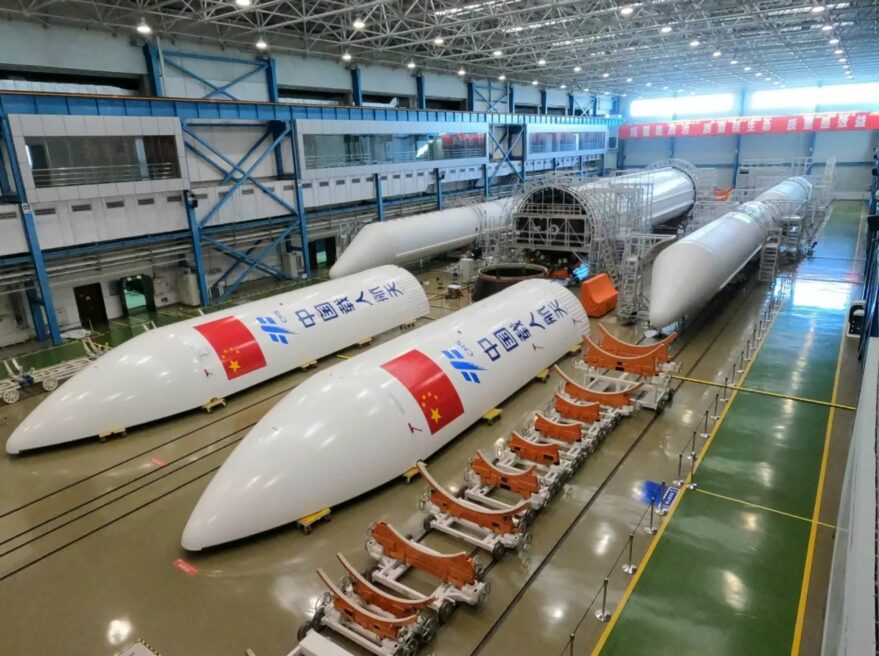Chinese rocket stage predicted to reenter atmosphere around May 8
By Andrew Jones

HELSINKI — A large rocket stage which launched China’s first space station last week is likely to reenter the atmosphere around May 8 according to early space tracking predictions.
U.S. Department of Defense Spokesperson Mike Howard in a statement May 4 said that “U.S. Space Command is aware of and tracking the location of the Chinese Long March 5B in space, but its exact entry point into the Earth’s atmosphere cannot be pinpointed until within hours of its reentry, which is expected around May 8.”
“Until then, the 18th Space Control Squadron will be offering daily updates to the rocket body’s location on www.space-track.org beginning May 4. We will provide additional information as it becomes available,” the statement read.
The launch of the Long March 5B late April 28 Eastern successfully placed the 22.5-metric-ton Tianhe core module into orbit. However the roughly 30-meter-long, 5-meter-diameter Long March 5B first stage also reached orbital velocity rather than fall with a predetermined area downrange.
The empty rocket body is now in a 162 by 306-kilometer altitude orbit according to U.S. 18th Space Control Squadron space tracking, down from an initial 170 by 372-kilometer orbit.
Without the ability to restart its engines the core stage will be dragged towards Earth by increasing collisions with molecules in the Earth’s atmosphere. Atmospheric fluctuations and other variables and the high velocity of the stage mean that accurate predictions of when and where the stage will reenter are not possible until a few hours before the event.
The Long March 5B core stage’s orbital inclination of 41.5 degrees means the rocket body passes a little farther north than New York, Madrid and Beijing and as far south as southern Chile and Wellington, New Zealand, and could make its reentry at any point within this area.
This morning's data on the altitude-versus-time of the Tianhe / CZ-5B objects. The core stage orbit continues to slowly decay as expected. pic.twitter.com/E8EPJ9yzRu
— Jonathan McDowell (@planet4589) May 4, 2021
An May 4 update from the Aerospace Corporation predicts reentry will occur May 9 at 12:37 a.m. Eastern (04:37 Universal time), with a margin of error of plus or minus 28 hours.
Russian space agency Roscosmos also stated May 4 that its Automated Warning System on Hazardous Situations in Outer Space (ASPOS OKP) indicated that the Long March 5B was set for an uncontrolled reentry.
Calculations by Russian experts indicate a reentry window of 9:00 p.m. May 7 to 4:00 p.m. May 9 Eastern, with more refined predictions to follow in the coming days.
China has yet to comment on the status of the Long March 5B. The country is planning 10 further launches of various spacecraft and launch vehicles to construct its three-module space station across 2021-22.
China is currently preparing to send the Tianzhou-2 cargo spacecraft to Tianhe in the next few weeks using a Long March 7 rocket. A first crewed mission, Shenzhou-12, is expected to send three astronauts to the new orbital outpost in June.
Notably two further launches of the Long March 5B are expected in 2022 to send the Wentian and Mengtian experiment modules to join Tianhe in orbit.
It is unknown if the China Academy of Launch Vehicle Technology (CALT) which designed and manufactures the Long March 5B, is or has planned alterations to the rocket or launch profile which would allow the core stage to either deorbit or fall to Earth on a ballistic trajectory.
The Long March 5B was designed specifically for launching modules for the Chinese space station into low Earth orbit. A test flight in 2020 also saw the core stage reach orbital velocity. That incident saw the stage reenter over the Atlantic Ocean with local reports suggesting debris from that 20-ton stage appears to have survived reentry and landed in the African nation of Côte d’Ivoire.

Holger Krag, head of the Space Safety Programme Office for the European Space Agency, Told SpaceNews that an average mass of about 100 tons reenters the atmosphere in an uncontrolled way per year.
“It is always difficult to assess the amount of surviving mass and number of fragments without knowing the design of the object, but a reasonable “rule-of-thumb” is about 20-40% of the original dry mass,” Krag said.
Unlike older Long March series rockets the Long March 5B core stage uses liquid hydrogen and liquid oxygen for fuel. Older-generation Long March 2, 3 and 4 series rockets use a toxic hypergolic propellant combination of hydrazine and nitrogen tetroxide, which would make debris surviving reentry potentially hazardous to anyone approaching the wreckage.
Debris from Chinese rocket launches from inland spaceports occasionally falls within inhabited areas. China is understood to take precautions against causing injury through safety notices, evacuations and calculation of rocket stage drop zones, as well as experimenting with technologies including grid fins and parafoils.
While much attention is paid to the threat to people on the ground and aircraft in flight from satellite and rocket components reentering, the Aerospace Corporation last year raised the issue of pollution from reentry.
May 5, 2021 at 03:44AM
via SpaceNews read more...

Post a Comment